72 Hour Havana Itinerary

In this 72 hour Havana itinerary, we drink countless mojitos, eat our way through a flourishing foodie scene, and, above all, meet so many wonderful people who are eager to show us the Havana they know. Cuba was unlike any other country we’d visited, and as we met person after person, we attempted to wrap our heads around this country and society that was such a juxtaposition to our own. We left with a plethora of knowledge, but also a lot of questions on what the future holds for the people of this island nation just 90 miles off our coast. On the last day of our trip, a wise Habanero told us, “Don’t try and understand Cuba because you cannot. Instead, drink a mojito and enjoy it here.”
We traveled to the island at a time when the relationship between Cuba and the US seemed to be heading South. For nearly two years, travel restrictions for Cuba had been loosening – Americans were entitled to travel to Cuba under a “general license” which most often meant partaking in “people-to-people” educational activities while in Cuba and filling out a form at the airport. Almost every major airline also began servicing Havana, making it affordable to get to Cuba from many cities around the country. In short, if you were interested in travelling to Cuba, you could.
We had been talking about making the trip to Havana since Obama loosened the regulations in December of 2014, but it wasn’t until Trump began discussing rollbacks of the legislation that we mobilized and booked our flights. As of November 2017, OFAC has published updated sanctions, prohibiting Americans from travelling to Cuba under this individual “people-to-people” license. To ensure economic transactions in Cuba are not benefiting the Cuban military, OFAC is requiring all people-to-people travel be conducted by organizations under U.S. jurisdiction, unless any part of the trip was booked before the original announcement on June 16, 2017. The updated sanctions do permit travelers to visit under a “Support for the Cuban People” category, which includes staying in private Cuban residences and eating at privately-owned restaurants. At this point, only time will tell how strictly this restriction will be audited and assessed!
Our trip rolled around in October, about a month before the updated sanctions were published. However, our journey hit another bump in the road, as the U.S. issued a travel warning for Cuba at the end of September 2017 – a week before we were scheduled to leave. Due to a number of diplomats experiencing symptoms of sonic attacks, the U.S. advised its citizens not to travel to the country, citing an inability to protect tourists from these unknown attacks. Though our families were weary, we didn’t deem the reports substantial enough to derail our trip.
As we were getting ready to leave, news reports about the attacks seemed to be everywhere and everyone seemed to be, once again, on edge about Cuba. However, we were delighted to land in Cuba and realize that politics were not at the forefront of people’s minds. A few people mentioned the “attacks”, mostly citing confusion and sadness about the possibility that Americans may have trouble coming to their country again, but they did not speak about the incidents with anger or hatred. After a few hours in Havana, we were relaxed and extremely grateful to have kept our plans in place.
For Americans, there are a few steps you must take at home in preparation for any trip to Cuba. Namely, you must take out enough cash for the entirety of the trip. American credit cards do not work in Cuba, so it’s very important to bring enough cash for your stay. It’s best to also visit a bank at home and exchange all the money you want to bring into either Euros or Canadian Dollars. Due to the embargo between the US and Cuba, American Dollar exchanges are subject to a 10% penalty which Euro and Canadian Dollar exchanges do not incur. We also brought a printed itinerary with us, outlining the educational activities we’d be partaking in (although I’ve never heard of anyone asking for this).
We left New York on a Thursday morning for a long weekend in Havana. We flew directly to Havana from JFK, where there is a special counter for Cuba check-in. At the airport, you will have to buy a Cuban tourist visa, which you will need to keep throughout your trip and present upon your exit from the country. The price of the visa varies from $50-$100 depending on what airline you’re flying; we flew Delta and paid $50. Aside from purchasing the visa, the only other step at the airport was to sign the OFAC “general license” form in which we checked off the box indicating we’d be partaking in a “people-to-people” trip. After 3 short hours in the air, we were in Havana!
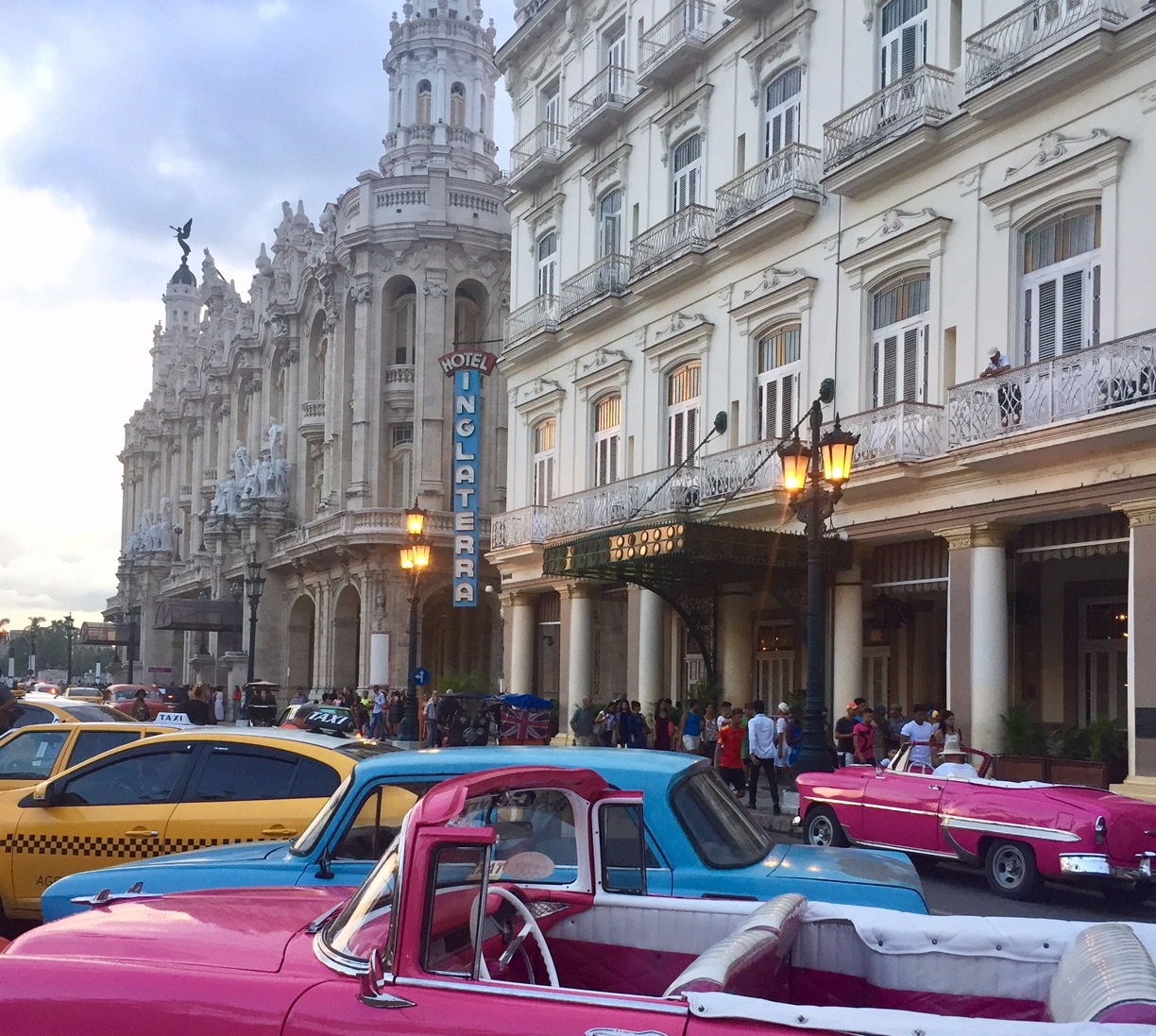
Day One
1 PM : Bienvenidos a Habana!
After landing and clearing customs, our bag was waiting for us at the luggage carousel, despite many warnings that baggage claim at the Havana airport was painfully slow. We had pre-arranged a pick up with our Airbnb host, and the driver was waiting for us at the Arrivals Hall as we exited. The first thing most people do in Cuba is exchange money at the airport to Cuban CUCs. The country actually has two currencies, the CUP (Cuban Peso) and the CUC (Cuban Convertible Peso). The CUC is the foreigner’s currency and is linked to the dollar, so the exchange rate is always 1:1. You will not need any CUPs for your visit, as most everyone we met had both (unless you visit Coppelia, more on this later). Most places will show prices in CUC, but if you do venture somewhere with CUP, they will most likely accept either. 1 CUC is equal to 25 CUP, so don’t be alarmed if you see a shop selling ice cream for 10, that means it’s CUP (not $10)!
You’ll most likely need to exchange money at the airport to pay your taxi driver for the trip to your accommodation. The line at the Arrivals level “cambio” was quite long, so we went upstairs to Departures where there were more booths and no one waiting. We were only able to exchange $100 at the airport, but there are “cambios” all over the city where we exchanged the rest of our money (if you’re staying in Vedado, we frequented the one located on Avenida 23 and J Street). We didn’t see a difference in exchange rates between the airport and the places downtown. All took a 3% service fee and an extra 10% fee for any exchange of American dollars. We did need our passports to exchange money in the city, so keep that in mind!
» A Quick Note about Taxis in Cuba
Depending on where you stay, you will probably be hailing alot of cabs. It’s important to negotiate with taxi drivers and to set your fare before the ride! The going rate from the airport is 30 CUC, and as it was our first trip (and pre-arranged) we paid this much. For our second cab ride later in the day, we paid 15 CUC. Then, when we started talking to locals we met, they made it clear that this way too much for any trip around the neighborhoods of Havana. In fact, they begged us to negotiate with the drivers, because when they get used to tourists paying them this much, they stop picking up the locals who won’t agree to rates this high.
By the end of our stay, we were only paying 5 CUC to get around and we only paid 20 CUC for our return trip to the airport. We found it worked best to tell the driver our address and then propose “cinco”? There were only a few drivers who turned us down throughout the weekend. There are tons of taxis in Havana, in fact everyone with a car seemed to be a taxi driver. You’ll get asked if you need a taxi 20 times while walking down the street, so don’t be scared to let one go if they are charging too much! As we quickly learned, everything in Cuba has two prices (yes literally in both currencies), but it’s also a place where you have to negotiate when you hail a taxi or buy anything. Even at the airport the cashier quoted a lower price when we said we didn’t have enough coins to buy a water at the original price!
After about 20 minutes, we arrived to our Airbnb in the Vedado neighborhood of Havana. The neighborhoods you’ll most likely find yourself in are Old Havana, Central Havana, Vedado, and Miramar. We really liked staying in Vedado, a more residential neighborhood a couple miles west of Old Havana. It has beautiful tree-lined streets and we were staying close to the University of Havana and Hotel Nacional. It’s nice to stay near a bigger hotel because you know you’ll have a reliable spot to find taxis, buy alcohol or cigars, or use the internet in the lobby! Although we took cabs to get to Old Havana, there were a number of popular restaurants, bars, and hotels which were still within walking distance! I’d recommend staying in Vedado or Old Havana, the latter if you want to be in the middle of the action at all times.
Our Airbnb was a block off Avenida 23, one of the main roads in Vedado. Although we usually book private apartments on Airbnb, we decided to stay in a shared apartment in Cuba! Private homestays, or casas particulares, are abundant in Havana. In 1997, the government began to allow Cubans to rent out rooms in their homes to tourists, providing them with new sources of income. Today, a lot of these are available on Airbnb, making it a great place to look for a place to stay! Our Airbnb had four private rooms, a kitchen, and a large living room. We appreciated having the host around every morning in case we needed advice, and enjoyed having a delicious breakfast spread at home every morning! I would definitely recommend staying in a casa particular in Havana and if you’ve never used Airbnb, you can get $40 off your first stay!
- Our Airbnb
- Calle 25 in Vedado
3 PM : The first of many mojitos at Hotel Nacional
If you arrive in Havana in the mid-to-late afternoon as we did, head to the Hotel Nacional for a drink and great views! The hotel is an icon in Havana, perched high on a hill overlooking the Malecón, the 8km long esplanade which runs from Old Havana to Vedado. Nat King Cole, Winston Churchill, Ernest Hemingway, Frank Sinatra, and Ava Gardner are some of the celebrities who have stayed at the Hotel Nacional since its opening in 1930. Our Airbnb was a quick 10-minute walk to the Hotel Nacional, so we got a first taste of our neighborhood as we walked down Avenida 23 towards the water. Make sure you download the Maps.me app before you head to Cuba and download the map for Havana. It’s an offline app, so you can see your location and search for your destination even while on Airplane Mode!
When you approach the hotel’s driveway, you’ll be instantly tempted to snap a picture of a vintage car chauffeuring guests to and from the hotel. Once you enter the lobby, you will be transported back in time, and can admire the mosaic tile, chandeliers, and vintage clocks. Head straight through the lobby to the back porch, where you can have your pick of couches. You can also head down towards the water, where you will pass another bar and can order your first Cuban pina colada (we deemed Hotel Nacional’s our favorite)! Although it will probably be the most expensive drink you enjoy in Cuba, it is still half the price of any you can find in New York at 7 CUC! With your drink in hand, explore the beautiful, sprawling hotel ground, and enjoy the ocean breeze.
If you need to alert anyone back home that you’ve landed safely, it’s very easy to buy wifi at Hotel Nacional. Head to the second floor business center, where you can buy a 1-hour pass for 5 CUC. Unfortunately, the card only works at the hotel, so you won’t be getting your money’s worth unless you stay for an hour or more. In general, this is expensive for a wifi card, but it’s an easily accessible one.
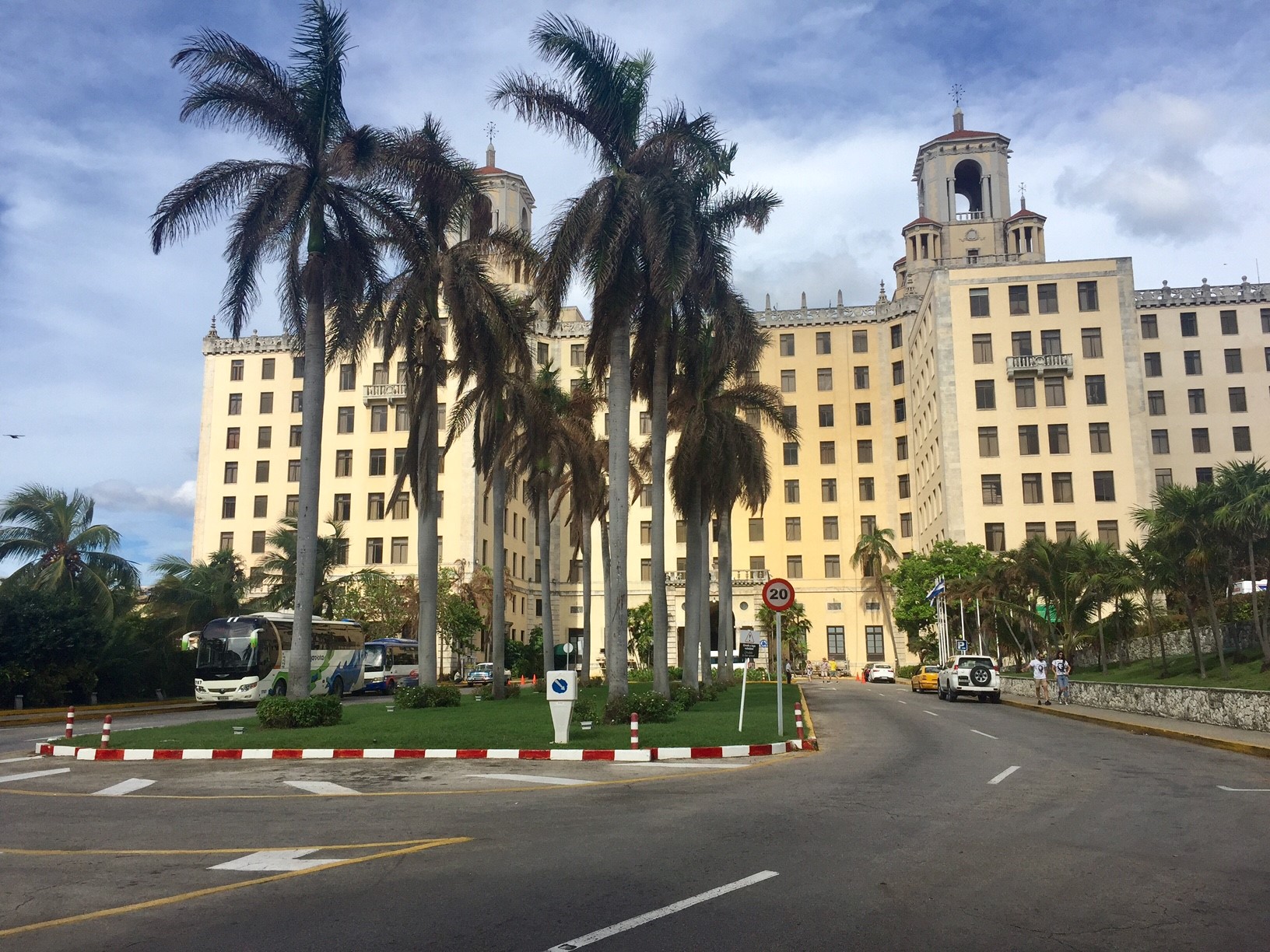
Grand Entrance of Hotel Nacional
- Our First Cuban Mojito!
- Backyard of Hotel Nacional
» A Quick Note about Wifi in Cuba
After exploring Cuba for a few hours, you will notice groups of people on their phones congregating in certain areas of the city. Wifi in Cuba is primarily limited to public wifi parks and nicer hotels and restaurants. To use the wifi in either of these places, you will need to buy a card from the internet provider, ETECSA. These are basic scratch-off cards with usernames and passwords which you will be prompted to enter once you find and select the “ETECSA” network on your phone (if the screen to enter the username and password does not automatically appear, you can also type 1.1.1.1 into the address bar in your browser). To get these cards, you can wait in line at one of the ECTESA centers around the city (you will need your passport at the official shop)!
Instead of waiting in the line (can be up to 2 hours), we bought cards from people waiting around the center to re-sell them. As mentioned, everything in Cuba has two prices and everyday goods such as toilet paper or wifi cards are sold “por la izquierda” or “on the left” – seemingly another name for the black market. Admittedly, it felt like we were buying something more promiscuous than wifi as we negotiated a price of 10 CUC for 4 cards (officially sold for 1.50CUC), but this second-hand market is common in Cuba. Just ensure you are receiving a card with a password which has not yet been scratched off! If you’re not comfortable buying off the street, you can buy these cards from many of the big hotels, but they will mark up the price to 4 or 5 CUC. If you are with friends and want to be able to use the wifi at the same time, you will need to buy more than one card.
Once you have the card, you can use wifi at most of the big hotels or at the public parks. You’ll know when you’ve found one because the ETECSA network will appear. We found the wifi to be faster at the hotels as there were fewer people trying to connect. Our Airbnb host told us if he’s trying to watch videos he often has to wait until the middle of the night when the networks have less traffic! The cards can be used over multiple sessions, so when you’re done browsing make sure you turn your wifi off to disconnect!
Some casas have begun to offer wifi in Cuba, but you’ll still need the card to connect. We finally got ours to work the last day we were there, a bit easier than huddling around a few benches! Although you will notice hotspots while walking around, you can look at the official list here. One of our favorite places to use our wifi cards was in the Iberostar hotel in Old Havana. It was the fastest we found! Although trying to connect to the internet in Cuba is a hassle, it was refreshing to spend time with people without phones as a distraction and to see people walking around without their phones glued to their faces!
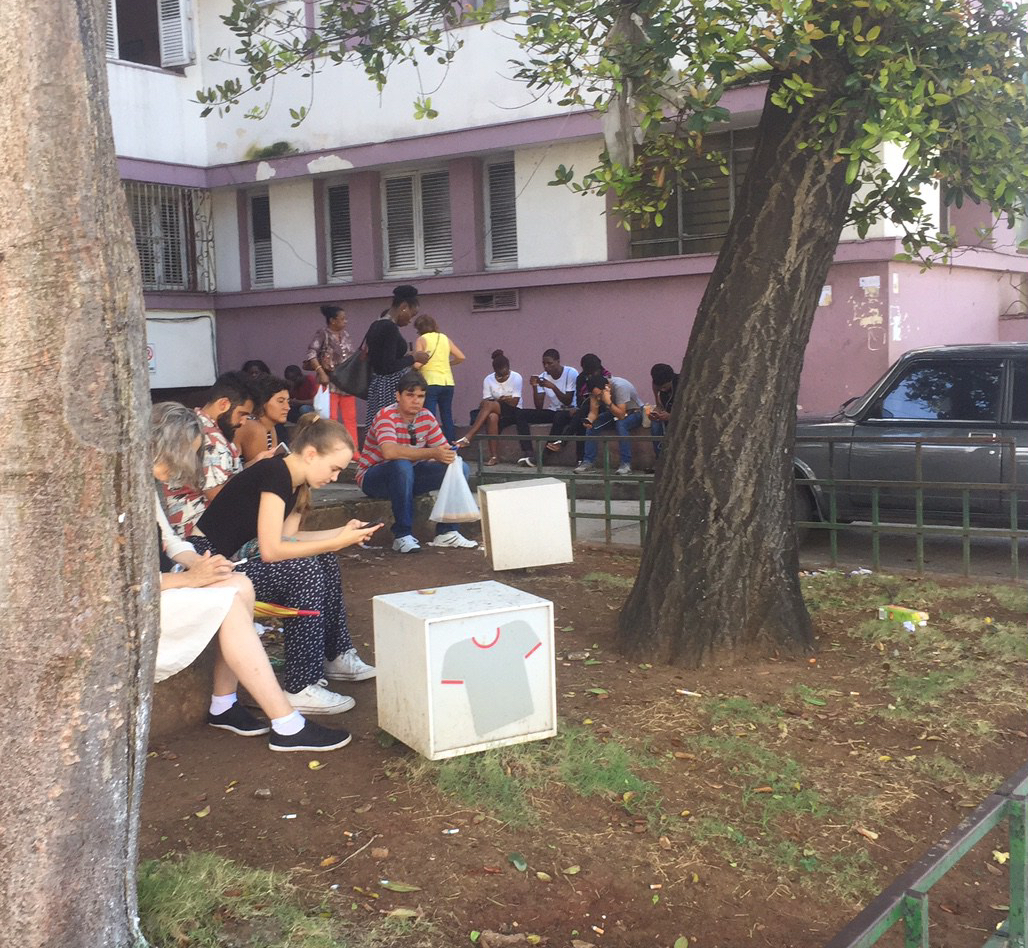
Wifi Park!
5 PM : Dinner at One of Vedado’s Best Paladares
We ate our first meal in Havana at Atelier, a paladar in Vedado. Although I’d read some so-so reviews of Cuban food, we ate very well in Havana! Since Raul Castro’s economic reform programme in 2010, lots of private restaurants, or paladares, have opened around Cuba and have drastically improved the foodie scene.
I always like to get my steps in after spending a few hours on a plane, so we decided to walk the 3km to the paladar from Hotel Nacional. We walked along the Malecon, where we admired the ocean and all the Habaneros socializing at the end of the day. If you’d prefer to take a taxi, there’s a plethora waiting outside Hotel Nacional, just don’t pay more than 5 CUC!
When you arrive at Atelier, you probably won’t even realize you have as there’s no sign on the building and it blends in with the other homes in the neighborhood. Once you do identify the building and climb the stairs, you will find yourself in a beautiful dining room, well decorated with Cuban art and antiques. The room is light and airy with large windows and doors on both sides and we sat on the lovely patio. The restaurant was completely empty when we showed up at 5:30, and we soon learned this was extremely early for dinner in Cuba.
We sipped on Cristal, Cuba’s authentic light beer, and a house-special sangria cocktail as we enjoyed the beautiful weather on the patio. We ordered the vegetable and brie appetizer and the surf and turf and chicken and shrimp in white sauce entrees. The food was delicious and we were very impressed with our first paladar experience! It’s recommended to make reservations at Havana’s most popular paladares, but not always easy to actually do so. Luckily, I found an email address for Atelier (admittedly after a few tries) and they confirmed our reservation in advance!
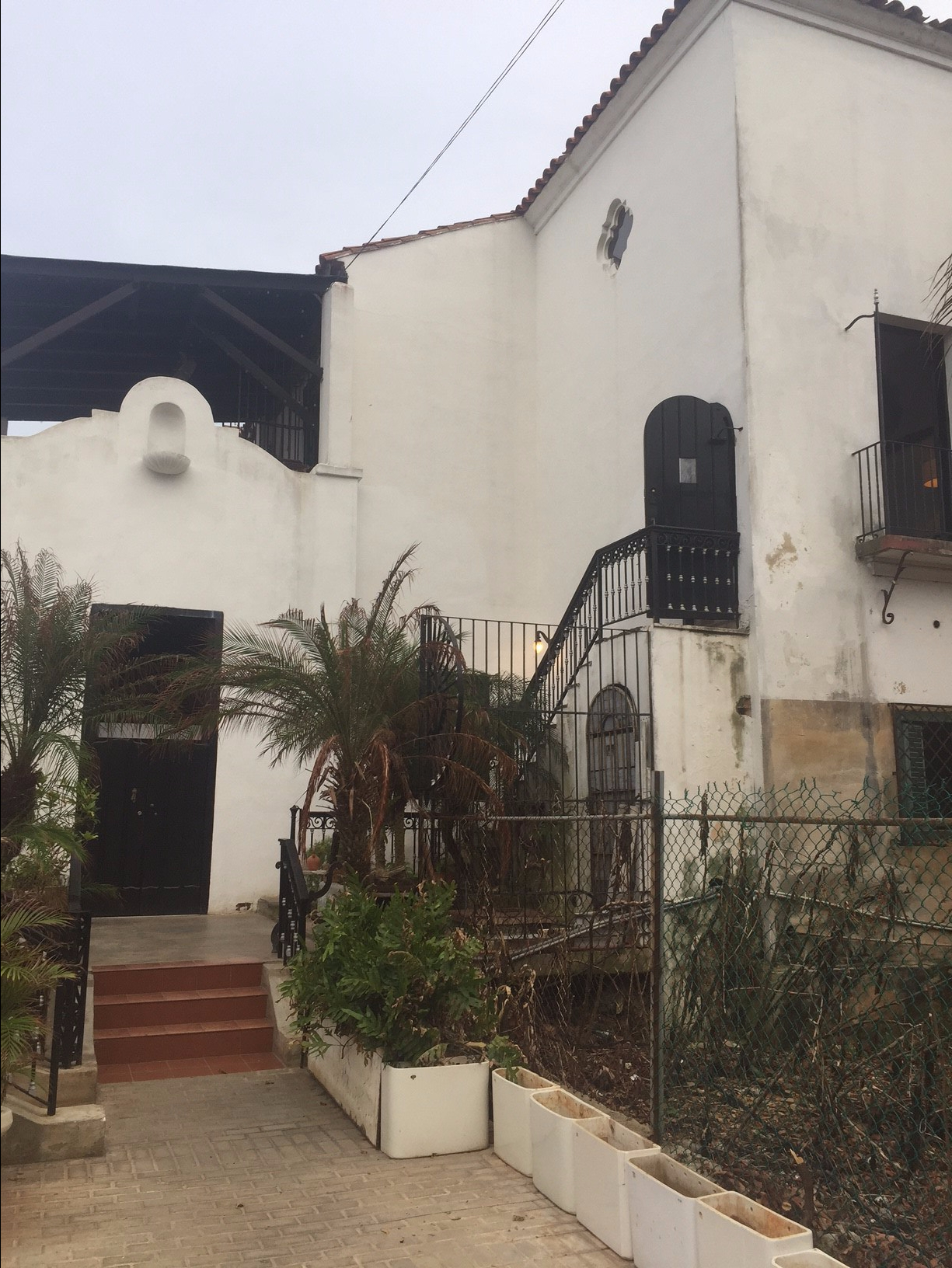
The Entrance to Atelier
- Chicken and Shrimp
- Surf and Turf
7 PM : Becoming Bartenders with Airbnb
After dinner, we caught a taxi to head to Miramar, the neighboring district to Vedado. Here, we were meeting Ariel, the host of Cuban Spirits Airbnb Experience. We’ve used Airbnb for a few years now, but this was our first time testing out the new experience offerings. There are tons of experiences in Havana from walking tours, to cigar making, to salsa lessons, and this cocktail making class. If you’re new to Airbnb, you can now also get $15 off your first experience!
We spent two hours with Ariel at a restaurant on the water with a beautiful view of the sunset. We learned how to make three classic cocktails: a mojito, a daiquiri, and a Havana Special, and then went behind the bar to make the drinks ourselves! Aside from having a blasting crafting the different cocktails, we got indispensable advice from Ariel on Havana’s best restaurants, bars, activities, and everything in between. He provided us with a plethora of practical travel advice: things to be aware of, how much to pay for taxis (5 CUC!), and so much more. His English was the best of anyone we met in Cuba and he made us feel incredibly more comfortable to spend the next few days in his country. It was a great first Airbnb experience and I’d 100% recommend!
- Havana Special and our Bartender!
- Sunset from the bar in Miramar
» A Quick Note about Cuban “Scams”
If you stick out as a tourist in Cuba, you’ll undoubtedly have people talking to you on the street. One thing we were told by a few tour guides was the worst thing that would happen to us in Cuba is we’d be ripped off. Cuba is not a violent country and the crime rate is very low, so you should not feel physically threatened while there. But, there are Cubans that know tourists have more money than they do, and attempt to take advantage of that. It’s a balancing act – we didn’t want to be rude and ignore people when they’d ask us with wide eyes where we were from, but also didn’t want to get roped into a conversation with someone just trying to sell us fake cigars.
I’d suggest to proceed with caution, don’t be scared of saying hello or telling people where you’re from, but if the conversation starts to turn into a tour or involves you going into a store or a home, assertively say “no thanks” and tell them you’re late to meet someone. These aren’t meant to scare you – if you’re aware of what to look for then there’s nothing to worry about!
1. Taxis – I’ve touched upon this one already, but anyone with a car becomes a taxi when tourists are around. Just ensure you agree upon your rate up front and always negotiate!
2. Cigars – A VERY common scam in Cuba is the sale of fake cigars to tourists. The typical experience is that someone on the street will start a conversation with you and the topic of cigars will come up. They will probably proclaim it’s “National Cigar Day” (it’s not), and will say they know someone who used to work in a famous cigar factory and have cigars available in their home for a lower price than in the stores. Although it’s true that these employees do get to keep some cigars, more often than not, these cigars turn out to be made of banana leaves and are completely fake. Don’t risk it!
3. Mom who needs milk – This is not something we saw in Cuba, but we were warned to be on the lookout for it by a few locals. The act here is that a woman with a baby will claim she needs milk and will direct you to a specific store to buy it. The price of the milk will be up to $20, the cashier and her will split the profits, and the milk will go back on the shelf.
9:30 PM : A Bit of Brooklyn in Havana
If you have a few hours left in you, catch a cab back to Vedado and head to La Fabrica del Arte Cubano. This former cooking oil plant has been reborn as a hip nightlife venue. Exploring the space is an activity itself, with dozens of different rooms including multiple floors of art galleries, a movie theater, performance spaces, and a few dance floors. We were surprised to be exploring such an avant-garde selection of art! From cartoons of Donald Trump to wallscapes of naked women, it was not the art gallery I was expecting to see in a government property. It says something about the degree of independence the government is giving to its younger generation, not only to its founder (Afro-Cuban musician X-Alfonso), but also the group of young musicians, dancers, and artists who are powering the exhibits. You’ll find a mix of sophisticated Cuban teens and intrigued tourists dancing the night away. What you get will depend on the night and season and ranges from fashion shows to plays, classical music to DJs, and salsa to hip-hop.
F.A.C. is open Thursday-Sunday from 8 PM to 3 AM. It does have opening “seasons” so be sure to check the website to ensure it’s open while you’re there. As you enter you’ll pay a 2 CUC cover charge and will be given a punch card to keep track of your drink purchases throughout the night. You’ll pay for what you’ve ordered when you leave, but don’t lose the card or you’ll be charged the 30 CUC fee. Grab a 40-ounce pina colada or mojito to sip on as you explore a whole different side of Cuba than you’ll see anywhere else!
Day Two
We started each morning with a bountiful breakfast prepared at our Airbnb at a table on the patio or in the living room with all the windows open. Each breakfast started with fruit, and what you’ll eat will probably depend on what’s in season! We had heard great things about the mango in Cuba, but were not able to find any because mango season had ended (May-September)! Each morning we enjoyed a plate of fresh pineapple, guava, and papaya, as well as bread with jam, cheese, ham, eggs, and of course, coffee!
- Breakfast spread
- View from the window
9 AM : Even Havana has a Free Walking Tour!
This morning we headed to Old Havana for a tour with Free Walking Tour Havana! The tours leave every morning at 9:30 (and at 4 PM in the afternoons) from Old Havana. We spent three hours with our guide and group of about 8 others as we explored the four main squares of Old Havana, the Cathedral de San Cristobal, the former presidential palace (now the Museum of the Revolution), and so much more.
Our guide was a middle school teacher from Havana and he taught us a succinct lesson on Cuba’s history as well as many details of current life in Cuba. Many of these guides work this tour as a second job (as you will learn, the official average monthly salary is about $25). There’s so much to see in Old Havana, so it’s nice to get your bearings with a local. Like other free walking tours around the world, the tour is completely donation-based!
- El Capitolio
- Gran Teatro de La Habana
- Basilica Menor de San Francisco de Asis
- Plaza Vieja
12:30 PM : Treasuring Hunting at Almacenes San Jose
Our walking tour ended in Plaza Vieja, and we made our way to Havana’s artisan market, Almacenes San Jose. This is a huge market with hundreds of vendors selling everything from t-shirts and magnets to handcrafted leather goods and beautiful paintings. Grab a fresh coconut water from one of the many stands and make your way through the aisles to pick out some gifts for your friends back home.
Although many of the stands are selling similar items, I was extremely impressed with the amazing artwork for sale! There’s art for every taste – from portraits of Che to cartoons of Obama, classic vintage cars to sweeping landscapes. We really enjoyed the political art, seeing lots of paintings with references to American culture and consumerism. There was one artist whose paintings reminded me of Andy Warhol’s, depicting American symbols around a Campbell can relabeled as “Cuba’s Revolution Soup”. Unfortunately, I couldn’t photograph the paintings as the artist was charging $1 for pictures! So check it our for yourself and definitely leave some room in your suitcase for a painting or two!
2:30 PM : Stop for Some Croquettes & Empanadas
If you’ve walked up an appetite, head to O’Reilly 304 for lunch or a few appetizers! It’s about 1 km away from the market, back into the heart of Old Havana. The restaurant is small, but there was a table available when we stopped in. Since we had eaten big breakfasts, we shared a few different appetizers of empanadillas (mini empanadas!) and croquettes. The restaurant is also well-known for its big, colorful drinks (both alcoholic and nonalcoholic) which are served in mason jars garnished with lime peels which wrap around the glass.
Skip dessert and instead try churros from a street vendor, some of the best churros we’ve ever had!
- Croquettes
- Empanadillas
- Churros!
3:30 PM : Stroll down Calle Obispo
Walk one street over from O’Reilly to Calle Obispo, the main walking street of Havana. The street is packed with art galleries, shops, and lots of tourists. As you explore some of the stores and stop to listen to bands playing inside the many bars and restaurants, make sure you also admire the well-preserved and restored buildings lining the street. There are also a number of museums along the street including the Numismatic Museum, 28 de Septiembre de los CDR museum, and the Mural Painting Museum. As you get to the other end of Calle Obispo, you’ll find yourself back near Parque Central, close to where the walking tour began this morning.
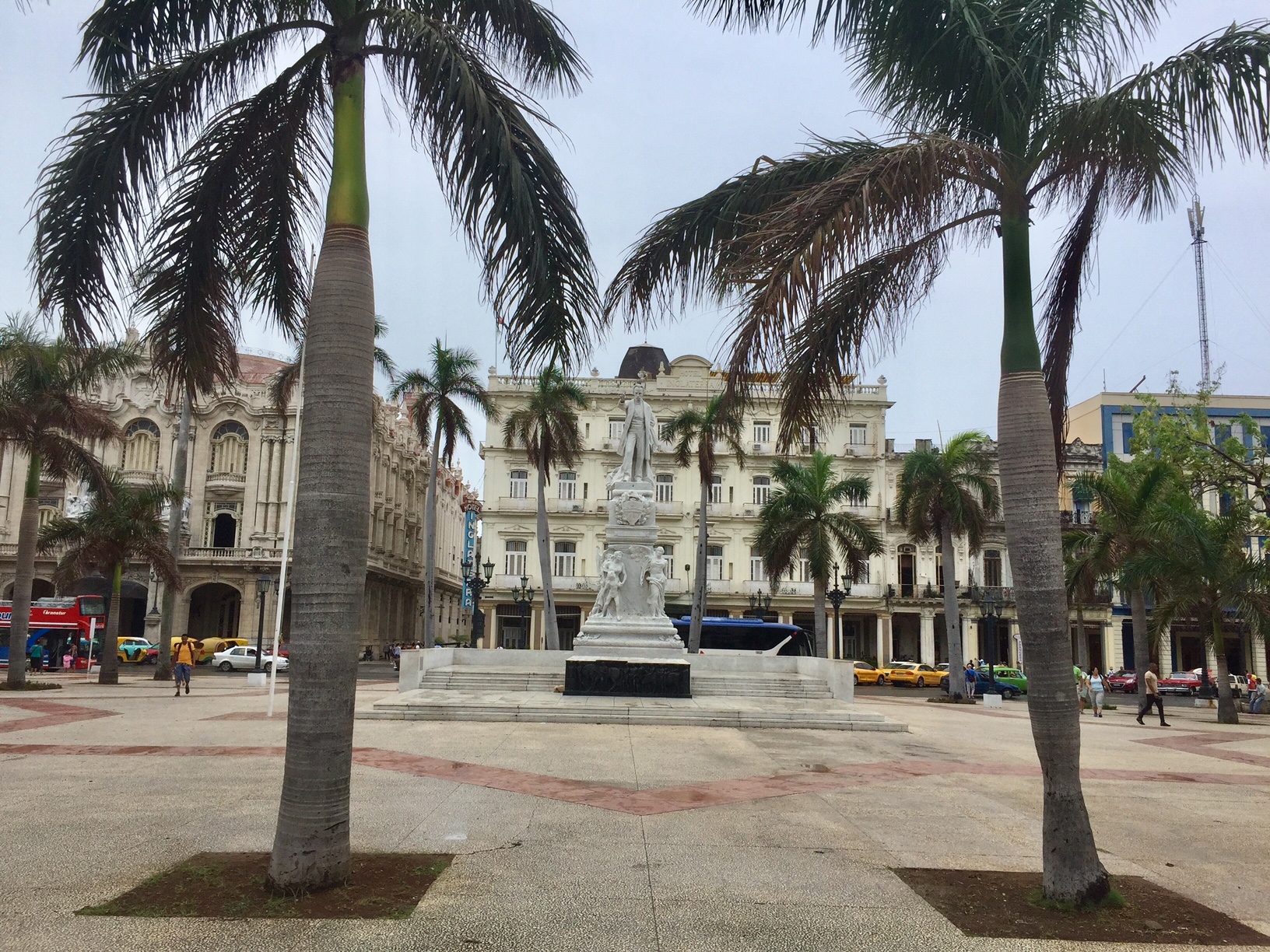
Parque Central
5:30 PM : The First of Hemingway’s Bars
Ernest Hemingway was a Nobel Prize winning American novelist and short story writer who spent 20 years living in Cuba, 10 miles outside of Havana in San Francisco de Paula. He’s become a fixture of Havana, falling in love with the city and staying there even after relationship between Cuba and the U.S. went South. Two bars have become synonymous with Hemingway’s social life: El Floridita and La Bodeguita del Medio. On display in El Floridita, you’ll find the now famous Hemingway saying, “My mojito in La Bodeguita, My Daiquiri in El Floridita.”
Head to the latter, El Floridita, to get a taste of Hemingway’s favorite Daquiri. The bar is a symbolic pink building, located at the end of Calle Obispo. El Floridita is a lively spot, filled with people enjoying dinner and others stopping by for a daiquiri or two. Sit at the bar, and watch as the bartenders whip up a seemingly never-ending flow of Hemingway’s favorite drink. If you’re lucky you might even get to sit near his statue, which has a permanent spot at the bar (and it’s very own daiquiri)!
- Daquiris!
- El Floridita
- Hemingway & his daquiri!
7 PM : Dinner at Old Havana’s Best Paladar
Head back towards Plaza de la Catedral (I know you’re really getting your steps in today!) to try another one of Havana’s best paladares. Doña Eutimia is tucked away at the end of a small street off the bustling square. Pass by the salesmen trying to lure you into the other paladares on the street, and you’ll find yourself in the intimate, charming Doña Eutimia.
The story of the restaurant is equally as charming as the paladar itself, dating back to the 1970’s. At the time, Plaza de La Catedral was where many artists had their studios and galleries, one of which was the Experimental Graphics Workshop, next to the current location of Doña Eutimia. The artists would eat lunch cooked by the woman next-door, Doña Eutimia. When the laws in Cuba loosened and people were able to open paladares, the artists created the restaurant as a homage to their favorite cook, to keep her recipes alive. The cuisine is very traditional Cuban, the dishes are not mixed with other cuisines or flavors like many other menu offerings around Havana.
As you peruse the menu, order the popular frozen mojitos, a bit of a twist on the Cuban classic. It was hard to choose just a few items off the menu, but we started with croquettes and an avocado stuffed with shrimp. The (football-sized) avocado was definitely one of our favorite dishes in Cuba. I wish avocados of that size were available in New York, imagine how much those would sell for! We also enjoyed the restaurant’s signature ropa vieja, which is made from lamb instead of pork or beef. If you have room, another dish to try is the Arroz a la Cuban, rice with fried eggs and plantains cooked in a tomato-based creole sauce.
Aside from being our favorite meal in Havana, Doña Eutimia was also the most affordable. Almost all, if not all, the items on the menu were less than 10 CUC and the frozen mojitos were only 3.50 CUC. Definitely make a reservation in advance as it’s a popular spot! I sent an email to the restaurant and got a prompt confirmation!
- Frozen mojitos
- Shrimp-stuffed avocado
- Ropa Vieja
9 PM : Completing Hemingway’s Bar Tour
It will be hard to want to leave Doña Eutimia, but when you do, make your way to La Bodeguita del Medio, just on the other side of Plaza Catedral. It’s impossible to miss La Bodeguita, with its constant crowd of people overflowing out of the restaurant and onto the street. The bar claims to be the birthplace of the mojito upon its opening in 1942, but this, along with whether or not Hemingway was a regular patron of the bar, is often disputed. Regardless, head to the bar to try a mojito yourself and also to sign the walls, just as famous patrons have been doing for years.
We did not think La Bodeguita had the best mojito we tried in Havana, but still recommend stopping for the experience and to try it for yourself. The bar also had a band which we enjoyed listening to on the small street outside the bar. Do be prepared to stand as the bar is tiny and doesn’t have many seats!
After spending about an hour at La Bodeguita, we walked the few blocks out to Malecón to catch a cab back to our Airbnb. As you follow Malecón back towards Vedado, you’ll likely see hordes of Cubans socializing and enjoying a beautiful night on the water.
- Crowd outside La Bodeguita
- Mojitos in the making
Day Three
9 AM : An Alternative to the Big Bus Tour
We woke up early again to enjoy breakfast at our Airbnb before heading out for the day. This morning, we had a few more sites we wanted to see and also wanted to hire a classic car for a tour, so we combined both and tailored the car tour accordingly! You can find the cars parked outside of the main hotels (Hotel Inglaterra/Parque Central in Old Havana; Hotel Nacional in Vedado).
We headed to Hotel Nacional, where there were at least 10 beautiful cars lined up waiting to take tourists out for the morning. We talked to a few of the drivers (you have to negotiate of course!) and chose a 1960 red Chevy Impala; what you get will be dependent on what you’re hoping to pay. We told the driver where we wanted to stop and agreed on a price of 25 CUC/hour. Although you can book similar tours online before you travel to Cuba, it’s much more cost-efficient to hire one day of!
Although you’ve probably ridden in a plethora of vintage cars by now, none are as impeccably conserved as the ones reserved for these tours. We also chose a convertible, and happily drove around the city, soaking up the sun and enjoying the breeze for the first 30 minutes of the tour as our driver recounted the history of his car – passed down from his grandfather, to his father, and now him.
Our first requested stop was Revolution Square, an iconic spot you will definitely recognize from pictures. Located in Vedado, Revolution Square is one of the largest city squares in the world at an impressive 11 acres. Named by Castro following the Cuban Revolution, it was where Castro would address a convened Cuban population. Today, it remains the political and administrative center of Cuba and continues to be used for important events. Most recently, it was filled with huge crowds in November 2016 – for a two-day ceremony following the passing of Castro himself.
The three major landmarks of Revolution Square are the José Martí Memorial, the Ministry of the Interior, and the Ministry of Communications. It will be impossible to miss the José Martí Memorial, the tallest structure in Havana. You will see many tributes to José Martí while in Havana, namely the international airport and this monument. Martí who is known as “Cuba’s apostle” was a poet, writer, journalist, a leader in the independence movement from the Spanish in the 19th century, and an advocate for justice. The monument was completed in 1958, constructed in the shape of a five-pointed star with a sculpture of Martí in front of it. The tower contains a small museum dedicated to Martí and an elevator which can be taken to the observation deck at the top of the tower.
A note of warning, as of now, the monument is under intermittent restoration and the observation deck is not open consistently. From what we gathered, there’s really no schedule or way to check if the deck is open. If it’s on your bucket list, you may just have to try your luck!
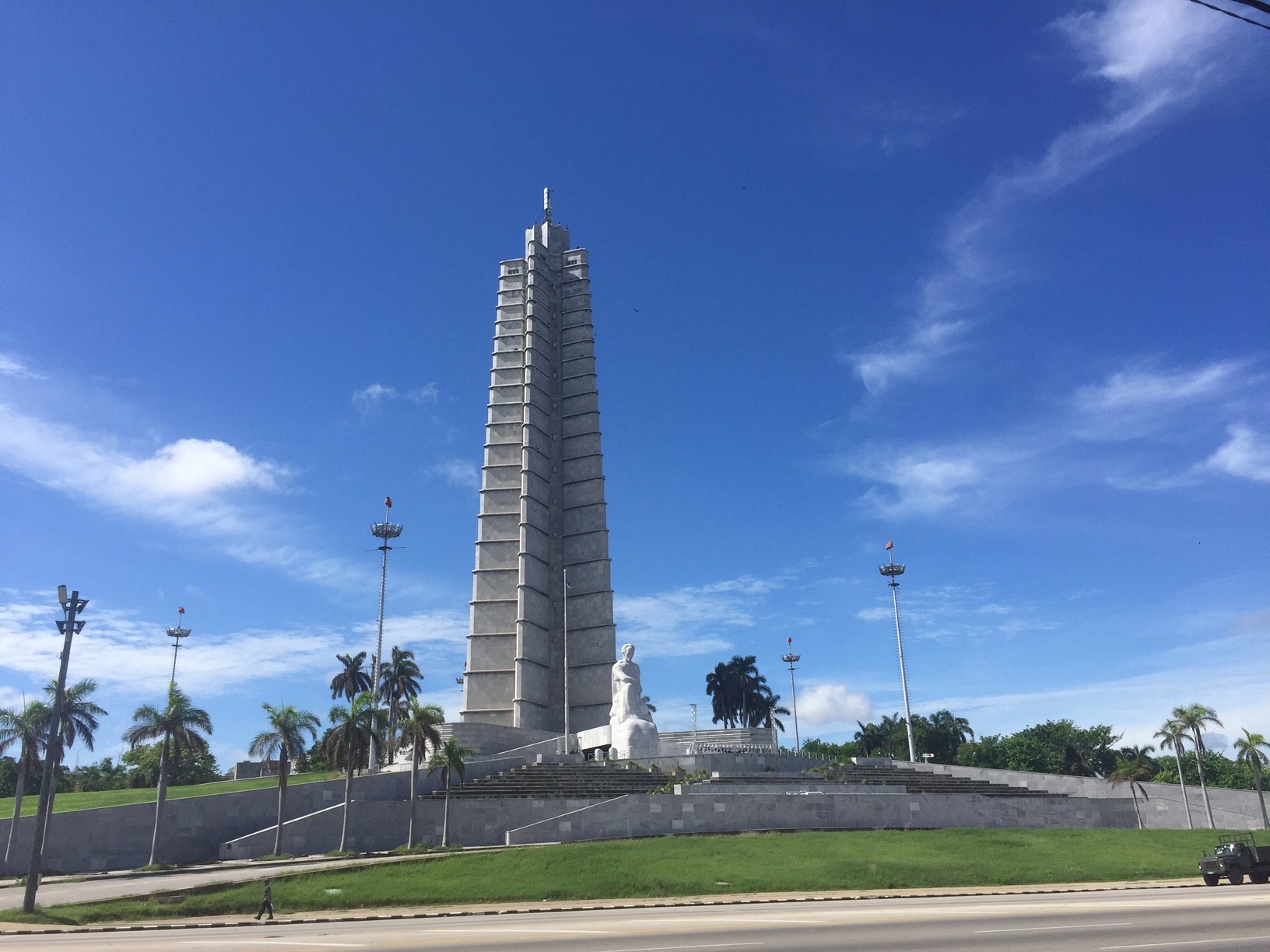
José Martí Memorial
Opposite the José Martí Memorial is the Ministry of the Interior building, which has become an icon of Havana due to its facade, a mural of Che Guevara. The mural and its accompanying phrase “Hasta la Victoria Siempre” (“Always Toward Victory”) are made of steel railings and were added to the building in 1995. This phrase is said to have been the signature of Che’s final letter to Castro before he was killed in Bolivia. You will see lots of tributes to Che around Havana, as he has been memorialized as a “professional revolutionary” and a key player in the Cuban Revolution. He was Castro’s right-hand man, serving as a military advisor after becoming famous for his leading of guerrilla troops in the overthrow of the Barista government.
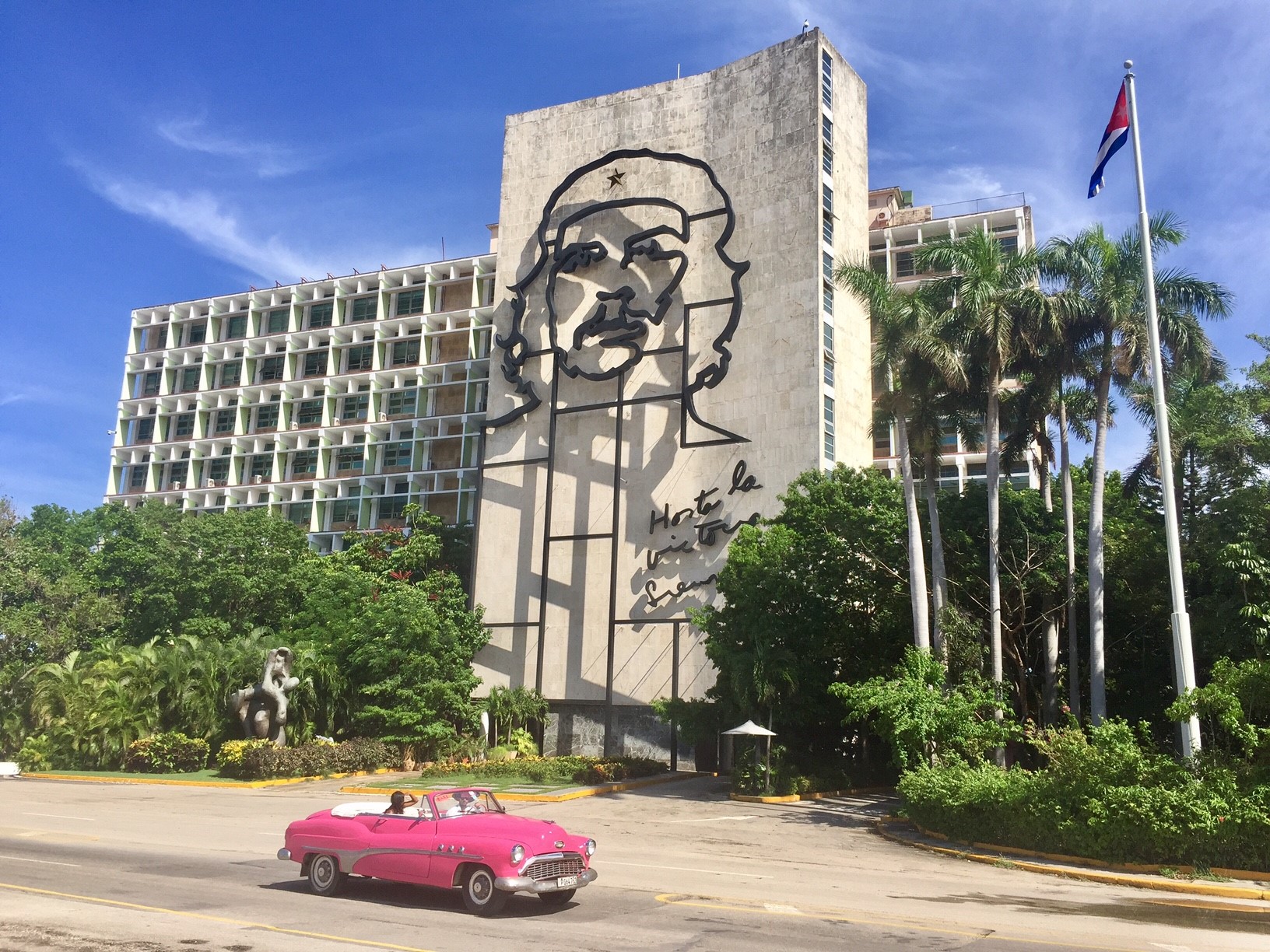
Ministry of Interior
On the adjacent corner of the square is the Ministry of Communications, which received its own visage in 2009 in the same style as Che’s. In honor of the 50th anniversary of Camilo Cienfuegos’s passing, he received his very own steel mural with the words “Vas Bien, Fidel” (“You’re Doing Fine, Fidel”). Cienfuegos is another hero of the Revolution, one of Castro’s top guerilla commanders, who became the head of Cuba’s armed forces. Fidel confided in Cienfuegos and this text is from a speech Fidel made in Havana in which he asked “Voy bien, Camilo” (“Am I on the right track?”). Cienfuegos responded with (you guessed it!) “Vas Bien, Fidel”.
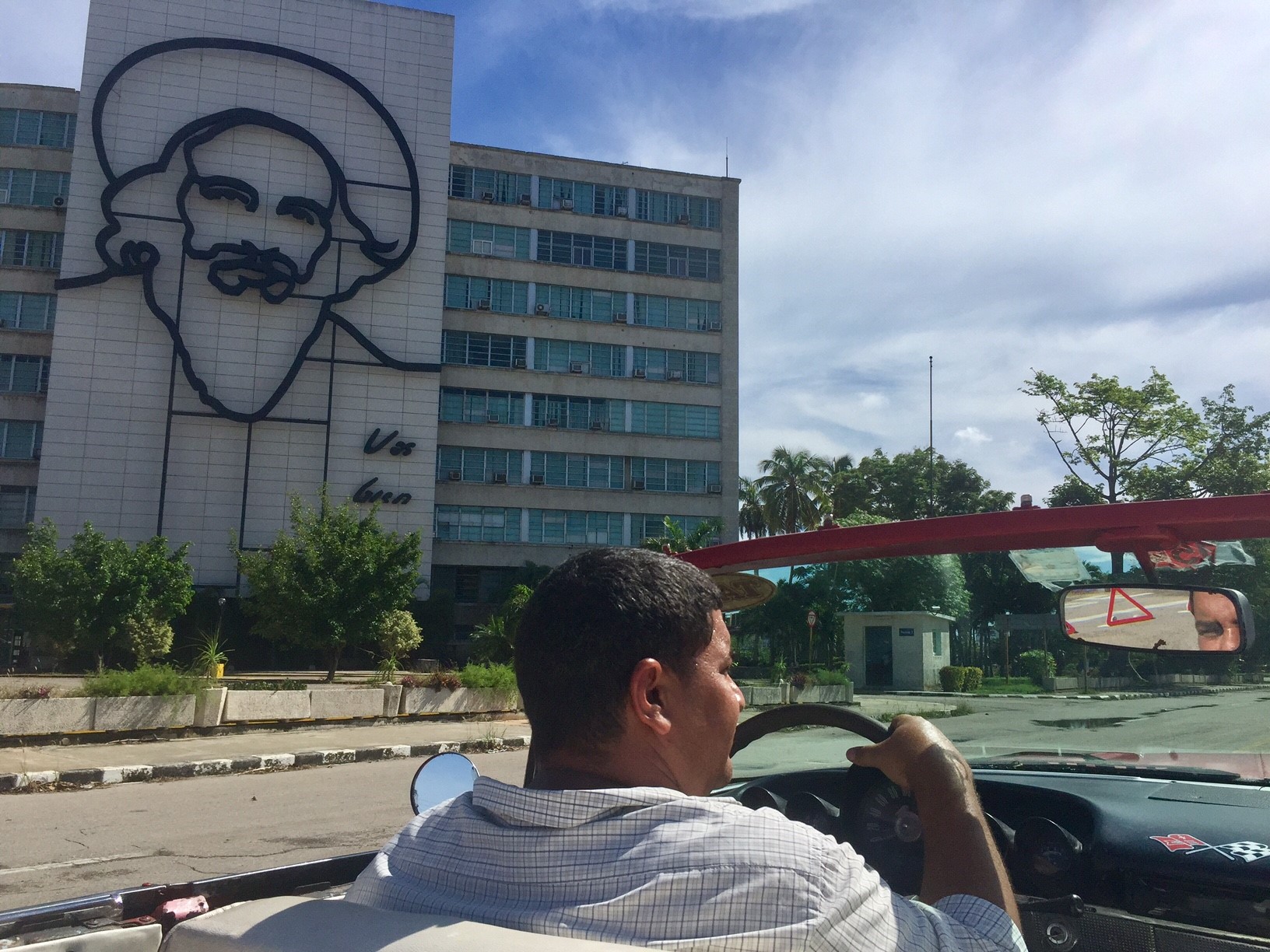
Ministry of Communications
Once you snap enough pictures of these iconic buildings with classic cars driving by, hop back into yours and make your way to the next stop, Fusterlandia. The drive out to Fusterlandia from Revolution Square is about 12km. It’s a beautiful ride through the Miramar district of Havana, especially with the top down! We drove down Quinta Avenida (Havana’s very own Fifth Ave!), which is a massive tree-lined avenue, with beautiful buildings on each side. Many embassies are located on this street, and I especially liked looking at all the impressive buildings which house them.
As you get closer to Fusterlandia, you’ll pass an area with several signs indicating photography is prohibited – the area in which Fidel Castro used to live. Although it was a secret for most of his life, it’s now known that he lived in this seaside town called Jaimanitas. Ask your driver to point it out!
In this same neighborhood, you’ll find Casa de Fuster, the house or “creative enclave” of artist Jose Fuster. After moving to this neighborhood in 1975, Fuster began transforming his own house into a work of art. His work has now spilt onto adjacent homes and walls. Fuster was inspired to transform his neighborhood into a work of art after seeing Gaudi’s work in Barcelona. His work is a unique dedication to the spirit of Santeria, an Afro-Cuban religion. His art served to not only beautify the neighborhood, but also to transform it from a rundown outskirt of Havana to a prosperous, continually-expanding art museum!
As the driver approaches the neighborhood, it will be impossible to miss the bright colors and intricate tiles covering walls, roofs, and doors! Once the car is parked, walk down the street and admire the murals covering the neighborhood – as of now more than 80 neighbors have allowed him to re-decorate their homes. As we approached the gate to the enclave, we were shocked to see how large and complex his enclave was!
As you walk up stairs covered in bold colors, you will find lots of nooks and crannies to explore. Every inch of the house is covered in sculptures, mosaics, and quotations from political symbols, animals, and Santeria saints. You can venture to the third-floor of the complex to get a great view of all of Fuster’s decades of work. It’s free to enter the complex, but you may want to bring some cash if you’d like to take a piece of Fusterlandia home with you or to give a donation. Keep in mind, the gallery section of the neighborhood is only open from 9 AM – 4 PM Wed-Sun, so if you go outside of those hours you will only be able to peek into the complex, although you will still be able to explore the neighborhood!
- Entrance to the enclave
- Neighboring chimneys

Fuster’s pool!
After spending about 30 minutes exploring Fuster’s house, we hopped back in our car to continue cruising around before getting dropped off in Miramar. Here, we were trying our second Airbnb experience, a cooking demonstration with a Cuban chef!
12 PM : Becoming Chefs (and so much more!)
Pascual hosted his Taste the Flavors of Cuba experience at an Airbnb in Miramar. It was the most beautiful house we’d seen in Cuba, with a beautiful backyard and most importantly, a beautiful kitchen. We walked into a kitchen stocked with an impressive spread of fruits and veggies, and having spent a few days in Cuba at this point, we had acquired a newfound appreciation for such a beautiful assortment of foods.
Ordinary Cubans don’t have the same access to food as we do in other parts of the world, and there are still government-run bodegas which ration groceries to citizens. Everyone is entitled to a set amount of basic food such as rice, eggs, and beans per month, but only families with children under the age of seven will be entitled to milk. And distribution is a serious problem in Cuba. Since nearly 80% of the food in Cuba is imported, stores will often go weeks without items and once they receive the shipment of that item, there will be a plethora of it. It isn’t uncommon to see only cheese available in the dairy aisle one day, only yogurt the next, etc.
For people with money, there are other options: farmer’s markets, vendors on the street, and supermarkets which sell goods in CUCs (tourist currency). But, for the average Cuban, the market prices at these stores are out of reach. As a chef, Pascual has CUCs and can afford to buy the items he needs for this experience, but it still requires abnormal amounts of time and patience, scouring different markets and stores for certain ingredients. Restaurants will have buyers, whose jobs are dedicated to finding necessary ingredients, sometimes forced to resort to the black market to buy seafood and premium imports. I had a profound gratitude as I sat in Pascual’s kitchen that we had access to such a beautiful spread of food.
Along with another couple, we pulled up chairs and tried many of the fruits and veggies in front of us, all of which were native to Cuba. Pascual prides himself on cooking authentic Cuban food with ingredients that can be found on the island. He discussed how the trend in many paladares around the city was to fuse Cuban cuisine with others, but he prefers to stick to authentically Cuban dishes.
As we continued to discuss Pascual’s journey to becoming a chef, he began to prepare some appetizers – an okra soup, fried plantains, fried yuca, and fried malanga. As Pascual began to prepare the main course, he taught us how to make mojitos (we were pros at this point!) and we all made our own.
- Okra Soup
- Fried plantains
- Fried Malanga
- Fried Yuca
Our main course was pork (or chicken) with rice, black beans, and mashed yuca. We also enjoyed a ceviche and a salad with the delicious Cuban avocados. Dessert was a piece of cheese and guava. At this point we had moved from the kitchen to the back porch of the Airbnb, where we ate in the beautiful garden. It was a great afternoon enjoying food with company who quickly felt like old friends. Pascual has worked incredibly hard to put together a special experience and is very passionate about cooking Cuban cuisine and sharing it with guests. I’d definitely recommend having your lunch with him!

Pork, rice, and mashed yuca!
4 PM : Aerial Views from Iberostar
After enjoying the bountiful meal, we shared a cab back to Old Havana with the other couple and headed to the Iberostar, a beautiful hotel on one edge of Parque Central. We took the elevator up to the 8th floor to find a huge rooftop with unbelievable views of the city. As we walked around the perimeter of the roof, we were most struck by the stark contrast between the condition of the buildings in each neighborhood of Havana. While the buildings on one side of the hotel (in Old Havana) are beautifully restored and well-kept, the buildings in Centro Havana are congested and rundown.
We spent close to an hour admiring the views, but you can also sit down for a drink while you take in the city. It’ll be hard not to want to jump into the beautiful pool on the roof! The Iberostar also had the best wifi we could find in Cuba, so if you need to send a few texts or pictures home, this is your place to do it! You will still need a card, but you can buy one here if necessary.
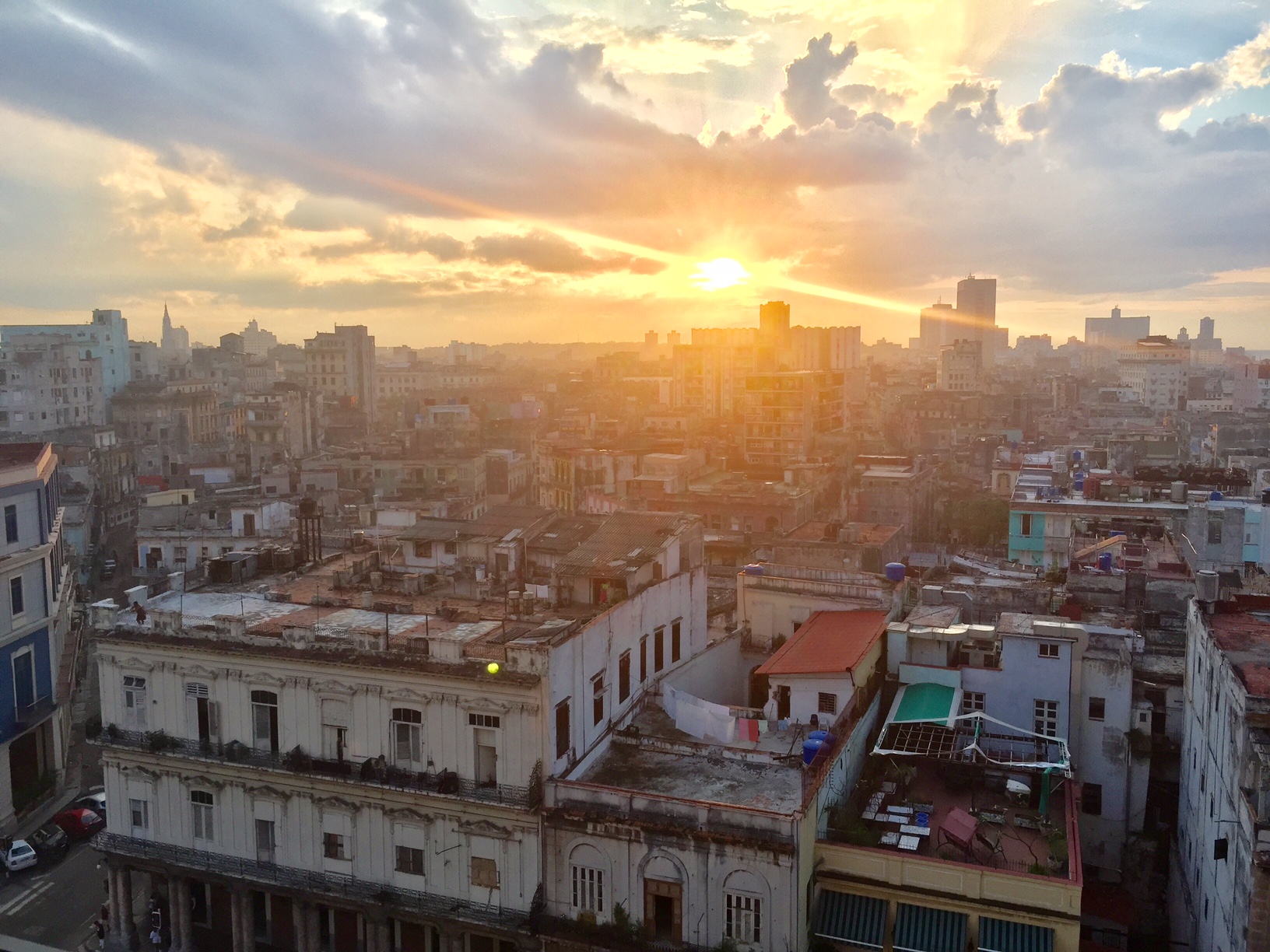
5:30 PM : Self-guided Walking Tour of Centro Havana
Up until this point, we had spent the majority of our time taxi-ing from Vedado to Old Havana, but hadn’t spent much time in the neighborhood in between – Centro Havana. This neighborhood is a stark contrast to Old Havana, whose buildings have received face-lifts and money for restoration in recent years. Centro Habana is often described as the “real” Havana, where buildings are falling apart, trash is on the streets rather than in cans, and sidewalks are cracking and crumbling. But, it’s also where you will find kids playing on the street, families gathered on chairs outside their homes, and women laughing as they are chauffeured down the street by makeshift pedal taxis. We wandered down the streets of Centro Havana as we made our way from one end of the neighborhood to the other, stumbling upon empty, yet beautiful buildings.
You can also wander to Callejon de Hamel, yet another public community art project in Havana! This small alleyway located between Aramburu and Hospital Streets in Centro Havana is filled with Afro-Cuban art. The facades of the buildings are covered with murals and much of the art is made from recycled items ranging from bathtubs to tires. If you are in Havana on a Sunday, you can stop by this area from 12-4pm when there are bands and dancers performing! This is the one area of Centro Havana where tourists are expected, so be weary of anyone trying to give you a tour – they will expect to be paid accordingly!
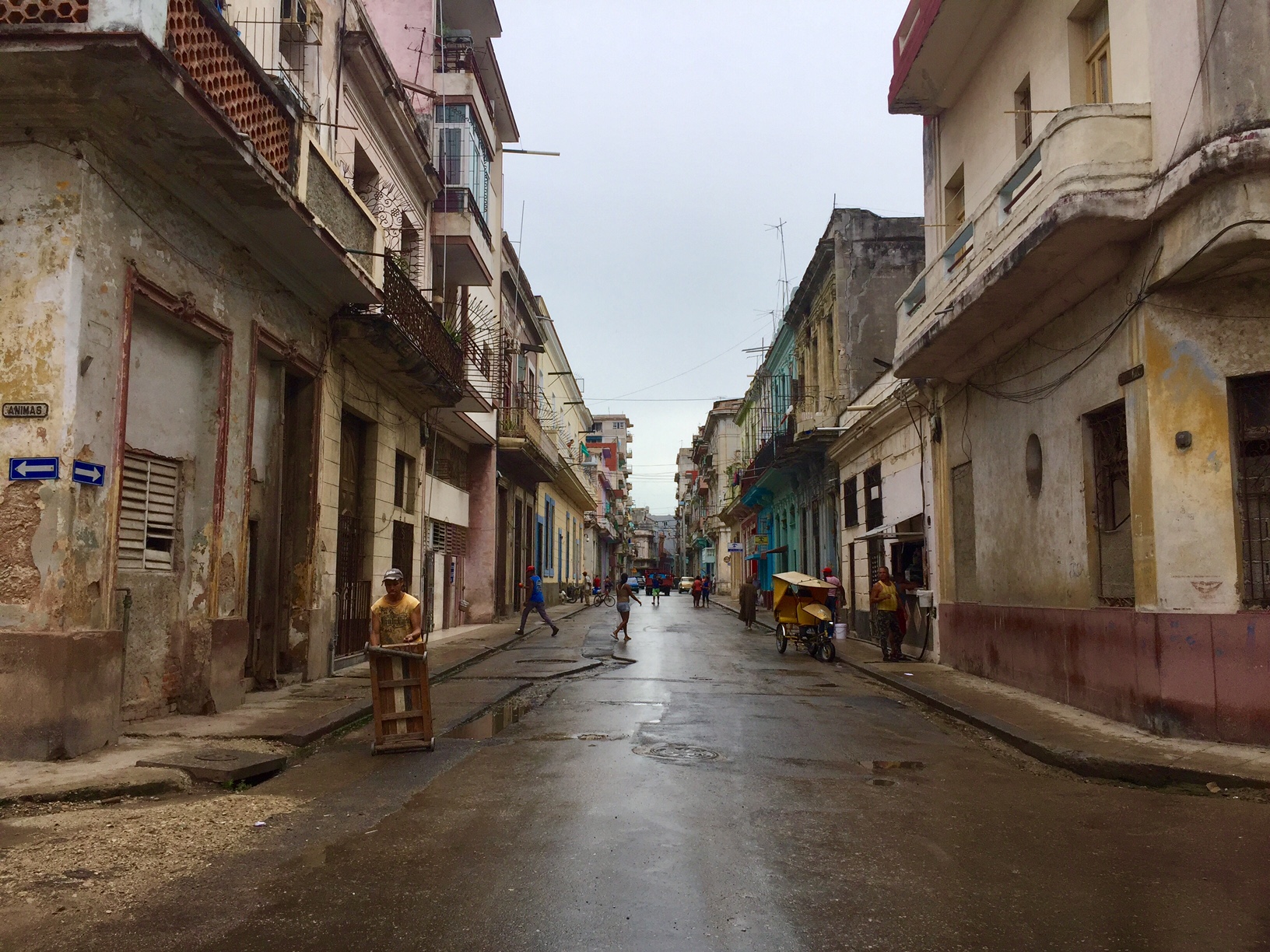
Street of Centro Havana
7:30 PM : Dinner at Centro Havana’s Most Well-Known Paladar
La Guardia is most likely the first paladar that comes to mind for many Cubans and tourists alike. Originally a filming location in the Oscar-nominated Cuban film Fresa y Chocolate, this multi-family building in Centro Havana transformed into a paladar in 1996. On the outside, not much distinguishes La Guardia from the other homes in Centro Havana. In fact, even the first and second floors of this building appear to be a (questionably) occupied home. But once you reach the third floor of the building, you will be transported to an elegant restaurant, with chandeliers hanging from the ceiling and antiques and paintings adorning the walls.
There’s something inexplicably special about La Guarida, maybe because it feels like you’ve been transported back in time, to a period when Havana really was a forbidden city in the Caribbean. As I adored the dining room at La Guarida, it also made me wonder what else was left to be discovered on the top floors of all the other crumbling buildings of Old Havana.
Head to the restaurant early to catch the sunset from the restaurant’s bar, located a floor above the restaurant. When we retreated back downstairs, we were seated at a lovely table on a small balcony off the dining room. We really enjoyed the two dishes we ordered at La Guardia – a tuna tartare with a vinaigrette and papaya and lobster with creamy rice. Although the lobster was the most expensive item on the menu at 22 CUC, it was more lobster than $22 would get you in the U.S.! Definitely make a reservation at La Guarida if you plan to visit while in Havana!
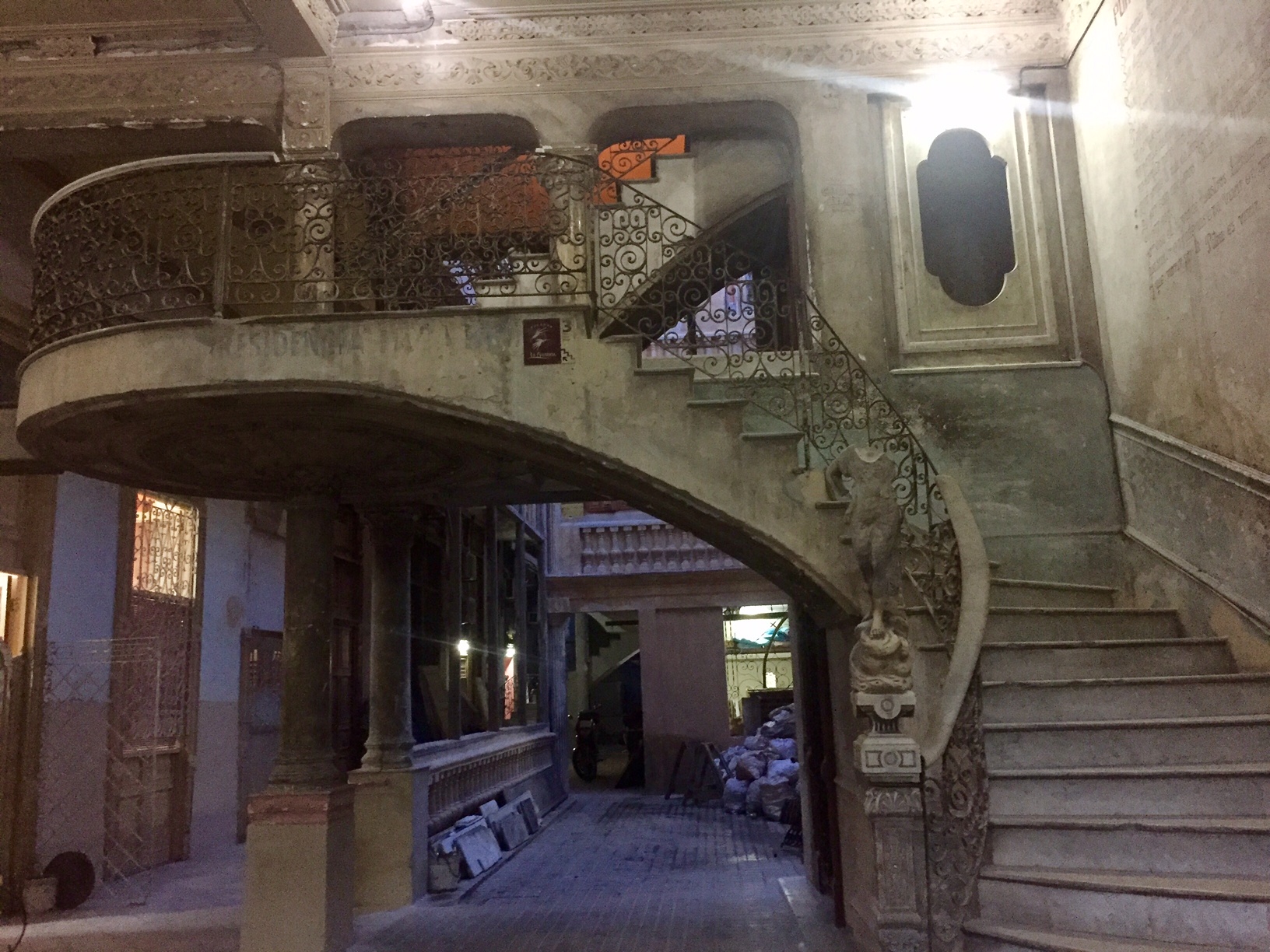
First Floor of La Guarida
- Lobster with Creamy Rice
- Tuna Tartare
10 PM: Experience the Rhythm of Cuba
We left La Guarida and caught a pedi-cab back to Vedado, about a 20 minute walk from the paladar. He dropped us at the border of Vedado, a few blocks from La Zorra y el Cuervo. The Fox and the Crow is a famous jazz club which hosts some of the best acts in town. Located on Calle 23 in Vedado (what isn’t?!) this spot is marked by an old-fashioned red telephone booth on the street, which also serves as its entrance. The club is intimate, dark, and unassuming, yet hosts world-famous musicians.
There is a show every night of the week, always with a 10 CUC cover charge which includes two house drinks. Although we’d heard there can be a sizeable line outside, we arrived shortly after 10 PM and were able to walk right in. The tables were only about half occupied when we visited, but a good number of them have obstructed views due to poorly placed poles, so closer you arrive to the doors opening at 10PM, the better your table will be.
We saw Lazaro Valdes & Son Jazz at La Zorra y el Cuervo and really enjoyed the performance. The group was a talented quintet, with Lazaro on piano, an extremely talented drummer, a guitarist, and two vocalists. On top of being talented musicians, the group was engaging, bringing a few members of the audience on stage with them to dance. They were having a good time performing and their energy radiated into the crowd. Definitely pay La Zorra y el Cuervo a visit to hear authentic jazz in Havana!
Following the show we walked back to our Airbnb, which was only a few blocks away!
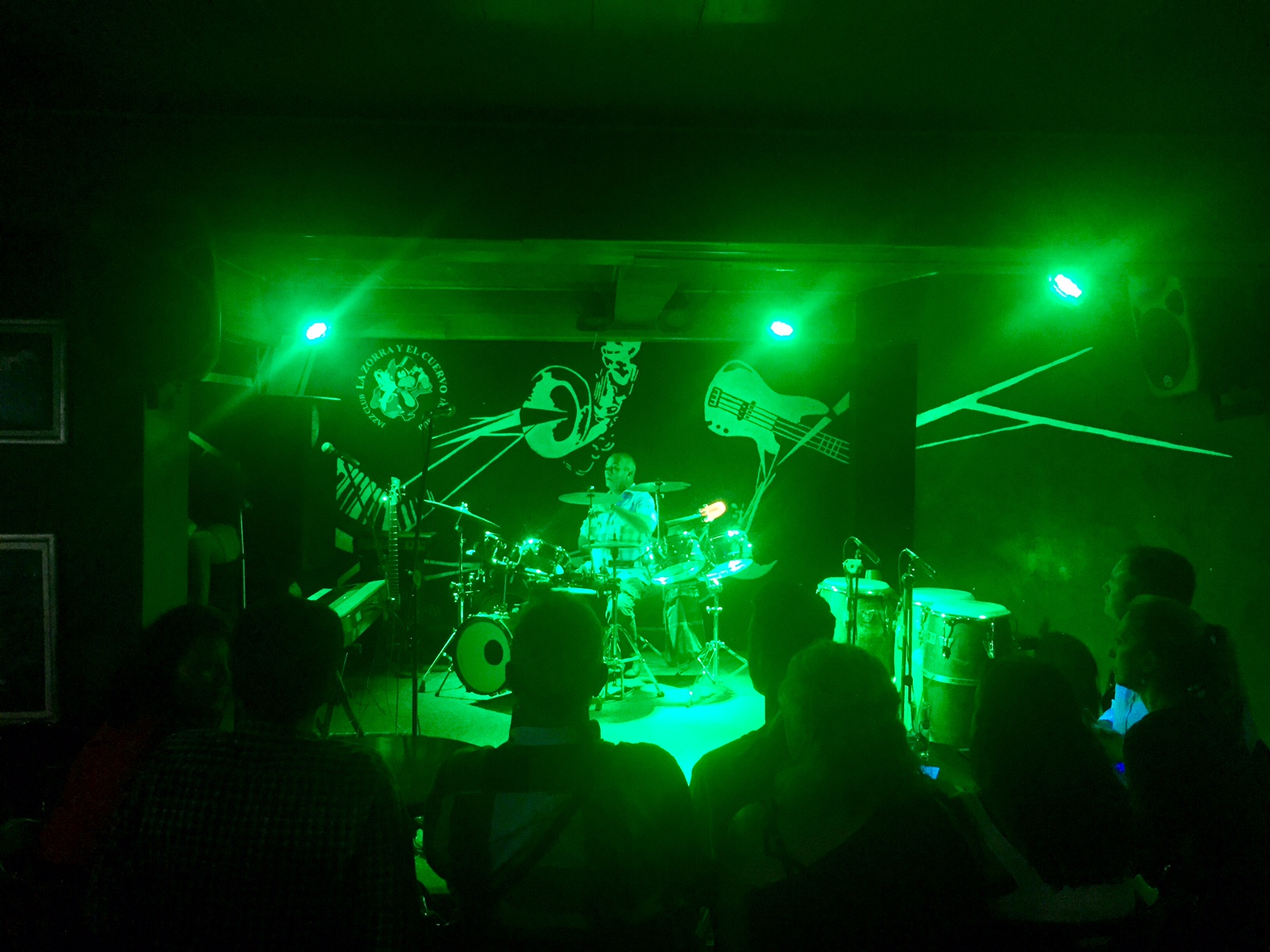
Lazaro Valdes
Day Four
10 AM : Ice Cream for Breakfast at Coppelia
Our flight wasn’t leaving Havana until the late afternoon, so we strolled around Vedado during our last few hours in the country. We ate our last breakfast at our Airbnb, but we knew we had to make a stop at Havana’s ice cream institution before heading to the airport. Coppelia is hard to miss, occupying an entire block on Calle 23 in Vedado, with hundreds of people always coming in and out. The building itself is unique, a two-story building which can fit 1,000 people and is shaped like a flying saucer. It’s been around since 1966, when Castro returned from a trip to the United States and wanted to introduce his love for ice cream to his people. Originally, the shop had 26 different flavors, rumored to be one more than any store he’d visited had.
You can learn so much about Cuba and its people from a trip to Coppelia. It’s a socialist institution, with prices that are kept low so as to be affordable enough for every Cuban. These low prices also mean Coppelia has huge lines and people are willing to wait for the ice cream for up to two hours. Despite this line, people frequent Coppelia. It’s where they go with their families for celebrations, with their friends at lunch or after school, and on many first dates. Aside from being a favorite snack, we had one tour guide tell us Cubans need ice cream – “it’s so hot here and we sweat so much, we need to eat back all the calories” he said.
If you’re willing to face the crowd, make your way to Coppelia to try the ice cream and experience the institution first-hand. An important note about Coppelia – it has designated an area for tourists and employees will be standing near the entrance looking for foreigners to escort them here. You’ll actually need CUP (local currency), if you want to bypass the tourist section and experience Coppelia as Cubans do. If you’ve been able to pick up any CUP on the trip (just ask your Airbnb host to exchange 1 CUC for 25 CUP), you should be able to afford the ice cream as a scoop is the equivalent of 4 American cents.
The employees (they actually looked like police when I first noticed them) will try and bring you to this separate section of the restaurant where you can pay with CUC, but if you show them you can pay in CUP, they should let you proceed to the regular lines. There are advantages to this tourist section, namely that you’ll get to skip the entire line, but you will also pay more accordingly and sit in a separate section. It will also help to speak Spanish here, but if you’re determined you can make it work with a few Spanish words.
If do end up in the general line, you’ll notice there’s more than one. Although you can attempt to choose the one that looks shortest, you never really know which line has fewer people in Cuba since the lines work a little differently.
» A Quick Note about Lines in Cuba
If you attempt to get in a line in Cuba as you would in most other countries, you’ll probably never find yourself at the front. Instead of actually forming lines as I’d consider “normal”, Cubans approach lines (which often look more like clusters of people), and ask the group who is last – “El ultimo”? This way, they identify who is in front of them, and when the next person comes, who is behind them. Once they know their spot in line, they can go off and do errands (or save their spot in other lines), before returning to the line as they please.
You’ll notice the lines look more like clusters of people at Coppelia. As long as you are comfortable queuing as a Cuban, you’ll be on your way to ice cream. You will notice that efficiency is not a concern at Coppelia – when it was our turn to ascend to the dining room, I immediately noticed a glaring amount of empty tables. It was also 10 minutes before we spoke to a waitress; they’re definitely not in a rush to turn the table!
After you sit, the waitress will (eventually) come and tell you the flavors for the day. You can’t expect to have certain flavors on a trip to Coppelia, availability varies day-by-day and they often only have a flavor or two available. When we were there, they had strawberry and tiramisu. Word on the street is the chocolate is only available in the mornings because it is the first to go.
The most common order at Coppelia is the mixed salad (“enslada mixta”) – five scoops of varied flavors. I know what you’re thinking… five scoops of ice cream?! We were also taken aback when told to order this many; I don’t think Coldstone Creamery’s largest size has that many! But, evidently, five is the minimum by most Cuban standards – we had a tour guide tell us he always orders 25. I didn’t believe him until we were at Coppelia ourselves and we saw tables of two women with 10 bowls of ice cream in front of them, each with the standard five scoops inside. Although some were there to enjoy the ice cream in one sitting, others were loading the treat into Tupperware containers to bring home and enjoy later.
We ordered the mixed salad for simplicity’s sake and, admittedly, the scoops are smaller than American standards, but it is still a healthy portion of ice cream. We tried both the available flavors, which came topped with small cookies. You may be disappointed in the quality of the ice cream if you’ve waited in line for two hours, but you’ve done as the Cubans do! We paid the 5 pesos per dish, which came out to 40 cents in total.
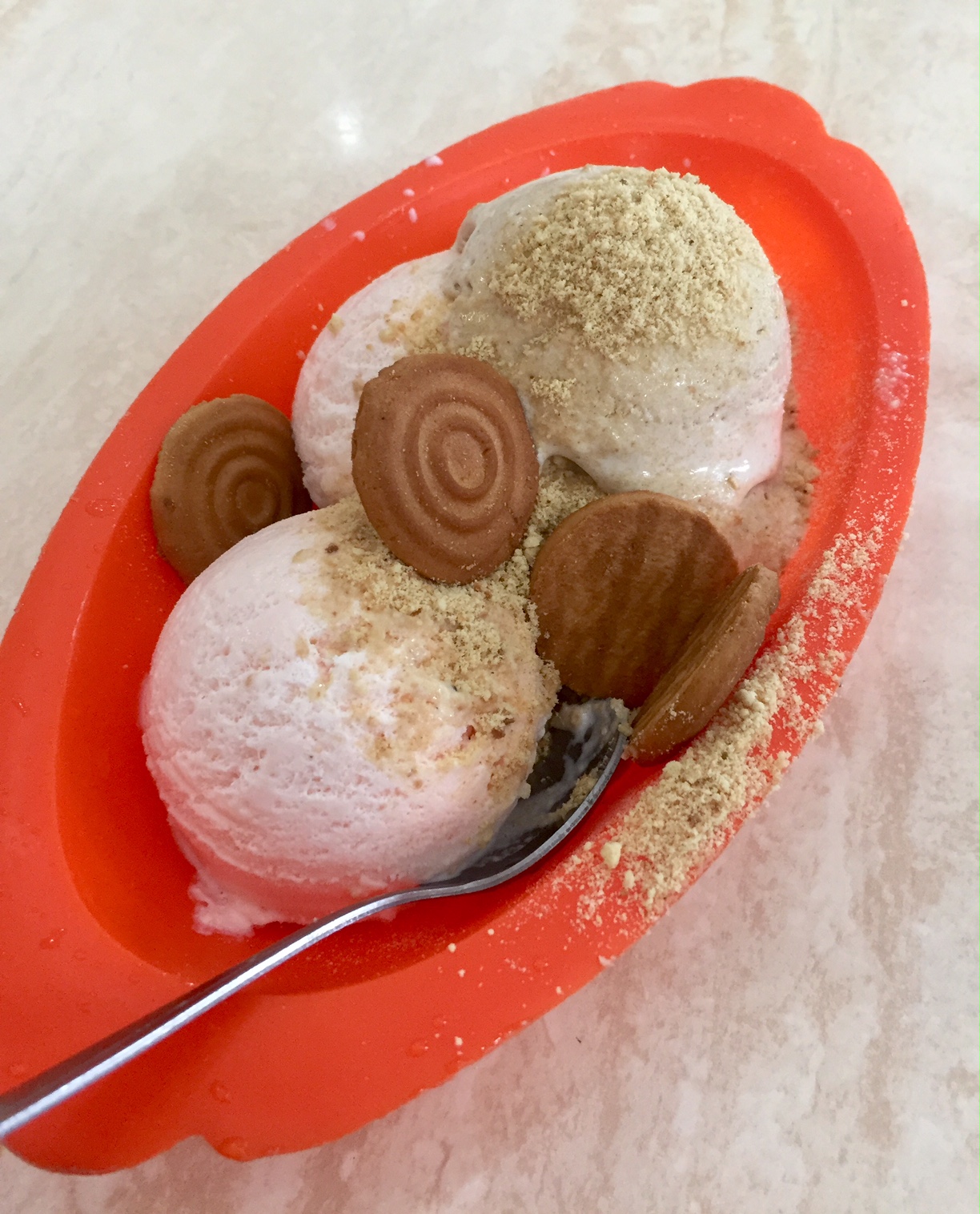
Mixed Salad!
12 PM : Until Next Time, Cuba!
After enjoying our ice cream, we packed our bags and hailed a taxi back to the airport. Although we had only been in Cuba for a long weekend, we saw alot and met dozens of great people. So, if you only have a long weekend, don’t let that deter you from making the trip to Cuba! If we’d had a few more days in the country, I would’ve looked into making day trips to Vedado and Viñales.
Make sure you get to the airport early if you’re planning to stock up on bottles of Havana Club as we were (or Cohibas)! Getting back into the U.S. was seamless, I recounted the plethora of people-to-people exchanges I had over the past few days to the customs officer and she let me on my way.
If you have any hesitations about visiting Cuba, you’re not alone. There may be more barriers to booking a trip to Cuba than there are to London or Paris, but it’s that much more rewarding. What I did understand after visiting Cuba is that despite political agendas attempting to polarize us, Cubans are still eager to welcome us with open arms. I hope our borders stay open so you can see this unique island in the Caribbean for yourself!

















































Theresa Richards
another fascinating and informative read! Photos are wonderful and right on the mark.
jon michaels
Nicely done. Easy to read and a great canvas of a busy weekend in one of the most amazing cities on the planet, with words and pictures that get nicely to the raw, un-sugarcoated yet still flavorful essence of it.
Beverly A Flowers
Great trip report. Thank you!
Robin
Thank you! This was an amazing read and I’ve noted down all of your recommendations